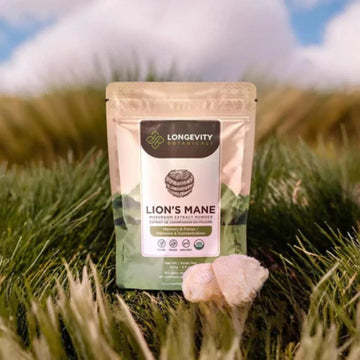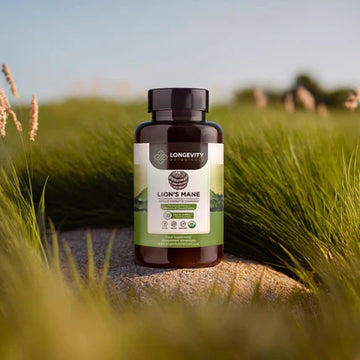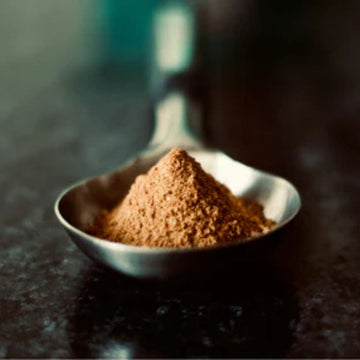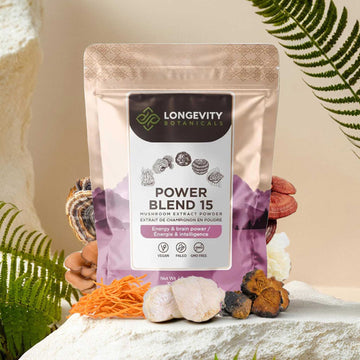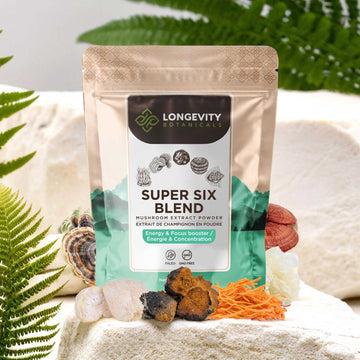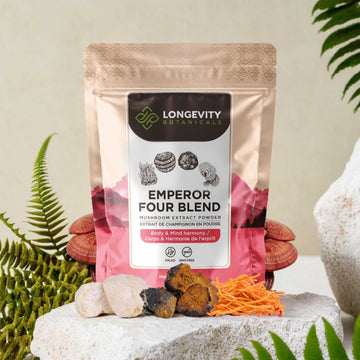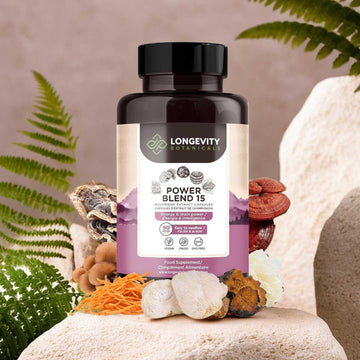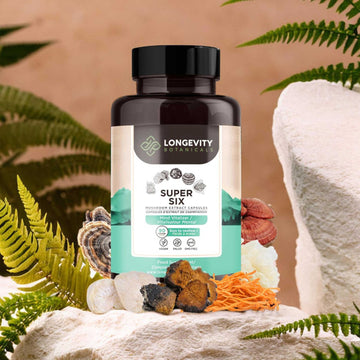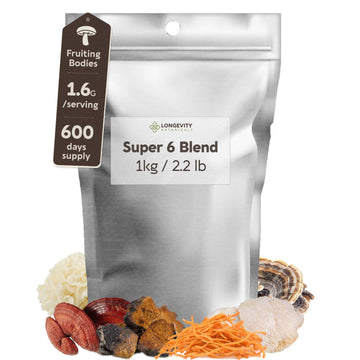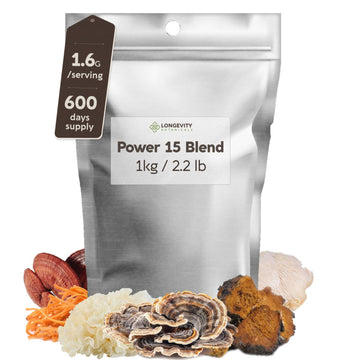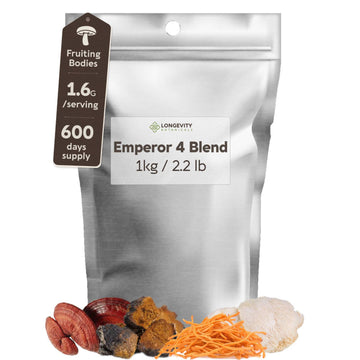Medicinal mushrooms have filled pharmacy shelves for decades but scientists now agree that one family of fibres, beta-D-glucans, does much of the heavy lifting. These glucose chains refuse to break down in the gut, so instead of feeding us calories they press molecular “doorbells” on immune cells and prompt a smarter, faster defence. This article unpacks how beta-D-glucans work, the strongest human studies behind their benefits, and the mushroom species that contain the richest supply.
1. What Exactly Are Beta-D-Glucans?
Structure in plain language: Picture a rope made of glucose links (the β-1,3 backbone). Short side twigs (β-1,6 branches) jut out regularly, forcing the rope into a triple-helix that digestive enzymes cannot snip.
Why the shape matters: Many bacteria and fungi display a similar pattern. Our immune cells have evolved receptors that “see” the helix as a rehearsal signal, not a threat, so they learn without unleashing excessive inflammation.
2. How Beta-D-Glucans Communicate With Immunity
Dectin-1 pathway: Macrophages and dendritic cells carry Dectin-1 receptors. When the β-1,3 spine fits the receptor groove, the cell switches on a Syk-CARD9 signal that boosts germ eating, antigen display, and balanced cytokine release.
Complement receptor 3: Soluble beta-glucan fragments latch on to neutrophils and natural killer cells through CR-3, steering them toward tagged invaders or abnormal host cells.
Trained immunity: A 2024 study on human monocytes showed that a single beta-glucan exposure rewired chromatin accessibility and metabolism, producing a memory-like readiness that lasted weeks
3. Evidence-Backed Benefits
Fewer colds and milder symptoms. A 12-week randomised, double-blind trial in 198 adults found that 250 mg of purified β-1,3/1,6-glucan reduced total respiratory-infection days by about one-third compared with placebo12-week randomized trial
Gut-microbiota harmony. A 2023 Frontiers in Nutrition review reported that beta-glucans increase Bifidobacterium and Lactobacillus populations which convert the fibres into butyrate, a short-chain fatty acid that seals the intestinal barrier and calms inflammationFrontiers review
Metabolic support. Human and rodent data summarised in a 2023 systematic review link regular beta-glucan intake with modest reductions in fasting glucose and LDL cholesterol by binding bile acids and slowing carbohydrate absorption
Fatigue reduction. A 2025 Nature Portfolio meta-analysis concluded that beta-glucans lower perceived fatigue scores, especially in high-stress populations, although heterogeneity remains
Tissue repair potential. Animal experiments show that oral or topical beta-glucans enhance collagen deposition and accelerate wound closure, a line of research now entering early human trials.
4. Mushrooms With the Highest Beta-D-Glucan Concentrations
Independent Megazyme assays of dried fruiting-body extracts reveal the following leaders. Percentages come from laboratory certificates referenced in our technical specs:contentReference[oaicite:7]{index=7}.
- Turkey Tail (Trametes versicolor) – about 50 percent. This makes it the flagship immune mushroom and the star of our Turkey Tail benefits guide.
- Maitake (Grifola frondosa) – around 30 percent. Maitake’s proteo-glucan, D-fraction, is widely studied for metabolic and oncology support. Learn more in our Maitake deep dive.
- Red Reishi (Ganoderma lucidum) – roughly 30 percent. Reishi pairs glucans with calming triterpenes, supporting stress management.
- Cordyceps militaris – about 30 percent. Cordyceps combines glucans with cordycepin, helpful for energy metabolism.
- Agarikon (Fomitopsis officinalis) – near 30 percent. An ancient respiratory ally with high β-glucan density.
- Lion’s Mane and Chaga provide 10-20 percent but shine for additional compounds like erinacines or melanin.
5. Why Do Percentages Differ?
Growing surface. Wood-grown mushrooms build thicker, β-1,6-rich cell walls, so they test higher than grain-grown mycelium.
Maturity. Beta-1,6 branches accumulate late in the fruiting cycle. Harvesting early mycelium can leave active glucans below five percent, a gap explored in fruiting body vs mycelium.
Extraction method. Bio-enhanced hot-water extraction adds chitinase enzymes, uses sub-boiling temperatures, and micronises the final powder to unlock more fibre while preserving the helix shape.
6. Extraction and Bioavailability
Hot-water foundation. Centuries-old decoction remains the core, because β-glucans are water soluble once cell walls break.
Enzyme assistance. Added chitinases puncture the chitin shield before heat loosens the fibres, raising yield without damaging the backbone.
Dual extraction. Some formulators collect an additional ethanol fraction rich in triterpenes, then recombine it with the water extract for broader activity.
7. Evidence-Based Dosage and Practical Use
Clinical range. Most human trials cluster between 250 and 1000 mg of active beta-D-glucans daily. A 2 g serving of a 50 percent Turkey Tail powder already provides 1 g of active fibre, covering the upper end.
Timing. Split morning and evening to keep receptors engaged throughout the day.
Stacking nutrients. Vitamin C and zinc assist phagocyte function. Prebiotic foods amplify gut fermentation of beta-glucans.
8. Safety Snapshot
Beta-D-glucans enjoy a long culinary record in oats, barley, and edible fungi. Reported side effects are mild, usually short-lived bloating or softer stool as the microbiota adapts. People using immunosuppressants or anticoagulants should consult a practitioner before starting high doses.
9. Selecting a Quality Supplement
Read the label. Demand a precise beta-D-glucan percentage, not a vague “polysaccharides” claim.
Seek fruiting-body origin. Lab comparisons show 5-to-15-fold higher active fibre than mycelium-on-grain products, a difference unpacked in our mycelium risks article.
Verify certificates. Reputable brands publish third-party tests showing heavy-metal safety and beta-glucan levels that match the label.
10. Future Research Directions
Bone-marrow programming. Oral beta-glucans shift stem cells toward myeloid lineages, a promising tool for vaccine adjuvants.
Metabolic disease. Investigators are exploring beta-glucans for insulin resistance, because trained macrophages in adipose tissue influence glucose handling.
Microbiota synergy. Mapping how specific gut microbes transform beta-glucans could lead to personalised fibre-plus-probiotic protocols.
Conclusion
Beta-D-glucans are not just another fibre, they are molecular educators that coach our innate immune cells, support a resilient gut ecosystem, and even influence metabolism. Turkey Tail tops the charts at about 50 percent active fibre, closely followed by Maitake, Reishi, Cordyceps, and Agarikon at roughly 30 percent. Extraction quality and dosing consistency determine how much benefit you actually feel. Aim for at least 250 mg of verified beta-D-glucans per day, choose fruiting-body-based powders that publish lab data, and enjoy the layered support these remarkable mushroom compounds provide.
